#European Trademark Registration
Text
European trademark protection: ipconsulting.EU
A trademark is a critical way to identify your business with high quality and unique personality in the business world. It is more valuable for traders also who want to enable them and possess their products and services to worldwide recognition. Applying for trademarks with our firm is simple, and EU trademark protection allows you to grow your business internationally.
European trademark registration is a scheme that allows individual and business trademark holders to protect their brands in all 27 EU member states.
It is a primary and planned process that provides traders with complete protection of their business rights. Ipconsulting’s expert advisors provide businesses with detailed information on this investment and guide them in all aspects of the registration process.
There are many advantages of EU trademark registration:
This registration offers businesses to easily set-up their goods and services on the global market with the help of this license. There are able to work globally.
Businesses can legally and privately guard their marks against being used unfairly by other parties or enterprises thanks to European trademark protection.
You will be appropriately guided in registering and obtaining your company license with the help of our services. We also assist you with the many steps of the registration process and provide thorough information on the advantages of European trademark protection. You can use our services more quickly and smoothly.
The procedure of requesting European trademark protection can be challenging in and of itself. For traders, approving the application by the numerous rules, techniques, and courses may take a lot of time and work, but IP consultancy can help. You can quickly register your name in the trademark list by consulting the EU's experienced consultants. We provide you with correct and complete documentation information to make your application quickly registered.
One of the benefits of our services is that European trademark protection services give you eligibility to trade and expand your business to countries other than European Union. This gives you more opportunities in the worldwide market to achieve more clients.
Conclusion
In conclusion, the EU trademark protection is the right way for businesses to promote their services worldwide. We are an IP consulting company that provides merchants the full advantages of European trademark protection to grow their business level!
#EU Trademark Protection#EU Registered Community Design Search#European trademark registration#Europe trade mark search
0 notes
Photo
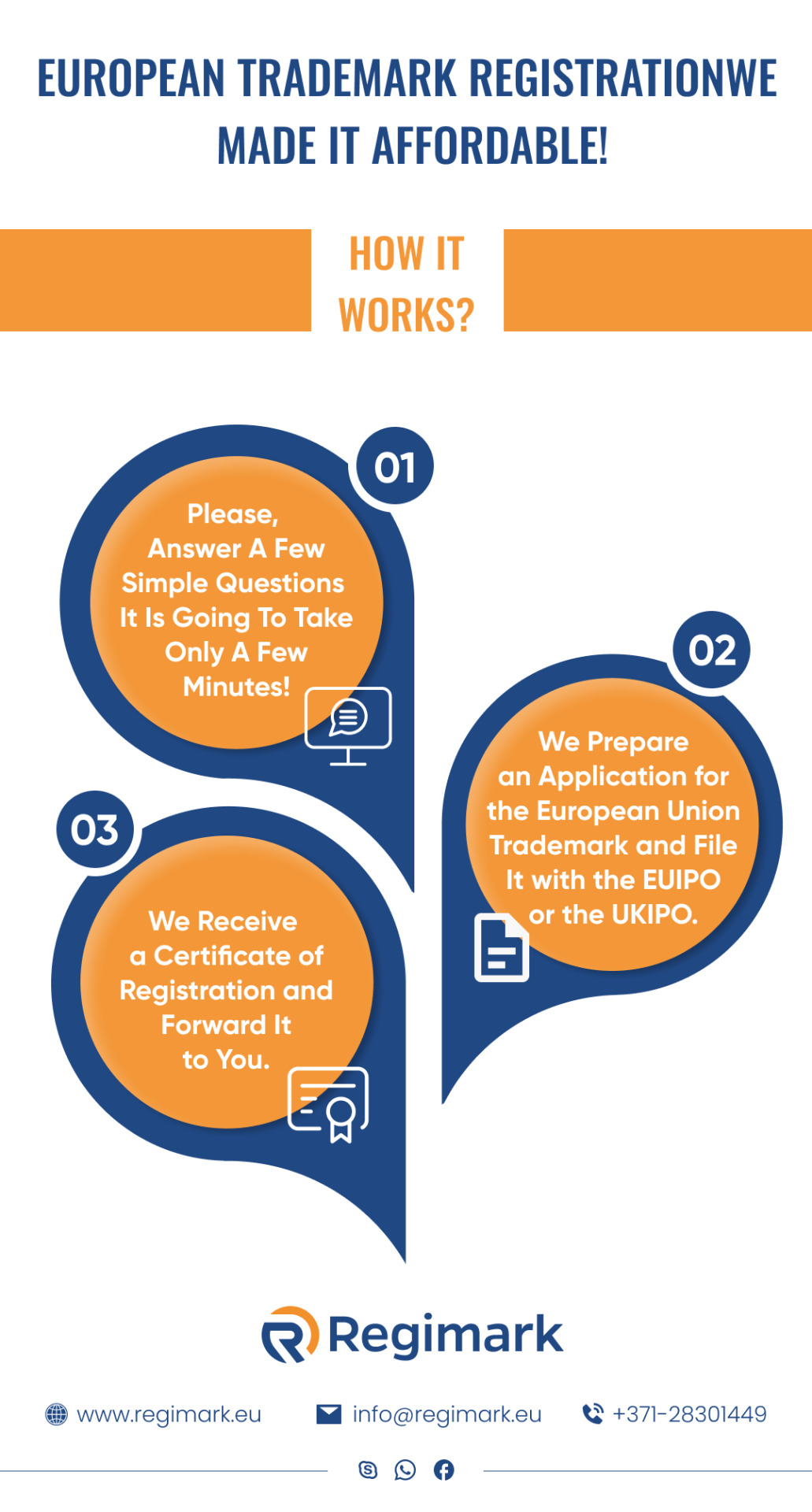
European Trademark Registration - How it Works?
The European Union trademark (EUTM) registration is an efficient and cost-effective procedure for obtaining trademark rights in the European Community. The EUTM System runs parallel to the trade mark legislation of each national EU member state. Registration is confirmed by the issuance of the trademark registration certificate. Know more details at: https://regimark.eu/eutm-registration/.
0 notes
Text
Website : https://en.intertaxtrade.com
Intertaxtrade, established in the Netherlands, excels in facilitating international business and assisting individuals in Europe with integrated solutions in tax, finance, and legal aspects. Registered with the Chamber of Commerce, they offer services like company management in the Netherlands, Dutch company accounting, tax intermediation, international tax planning, business law consulting, EU trademark and intellectual property registration, international trade advice, and GDPR compliance. Their expertise in financial and accounting services ensures clients have a clear financial overview, aiding in business success.
Facebook : https://www.facebook.com/intertaxtrade
Instagram : https://www.instagram.com/intertaxtrade/
Linkedin : https://www.linkedin.com/in/ramosbrandao/
Keywords:
company registration netherlands
legal advice online
comprehensive financial planning
financial planning consultancy
international business services
international business expansion strategies
gdpr compliance solutions
international trade consulting
european investment opportunities
gdpr compliance consulting services
in depth financial analysis
gdpr compliance assistance
cross border tax solutions
netherlands business environment
european union business law
dutch accounting services
tax intermediation solutions
international tax planning advice
eu trademark registration services
investment guidance online
business law consultancy
corporate tax services netherlands
financial analysis experts
business immigration support
startup legal assistance online
european market entry consulting
international financial reporting services
business strategy netherlands
tax authority communication support
international business law expertise
dutch commercial law advice
global business strategy services
european business consulting online
international business services platform
expert legal advice online
efficient company registration netherlands
reliable dutch accounting services
strategic tax intermediation
proactive international tax planning
eu trademark registration support
tailored investment guidance
specialized business law consultancy
dynamic international trade consulting
holistic corporate tax services netherlands
streamlined business immigration support
online startup legal assistance
strategic international business expansion
european market entry planning
innovative cross border tax solutions
navigating the netherlands business environment
european union business law insights
accurate international financial reporting
proven business strategy netherlands
exclusive european investment opportunities
seamless tax authority communication
in depth dutch commercial law advice
comprehensive global business strategy
proactive european business consulting
one stop international business services
personalized financial planning solutions
expert legal advice for businesses
quick company registration in netherlands
trustworthy dutch accounting services
strategic tax intermediation solutions
innovative international tax planning
efficient eu trademark registration
tailored investment guidance online
business law consultancy expertise
comprehensive corporate tax services netherlands
thorough financial analysis support
streamlined business immigration assistance
navigating netherlands business environment
european union business law guidance
international financial reporting accuracy
business strategy for netherlands market
european investment opportunities insights
efficient tax authority communication
international business law excellence
dutch commercial law proficiency
global business strategy implementation
european business consulting excellence
comprehensive international business services
proactive financial planning strategies
expert legal advice on international matters
#company registration netherlands#legal advice online#comprehensive financial planning#financial planning consultancy#international business services#international business expansion strategies#gdpr compliance solutions#international trade consulting#european investment opportunities#gdpr compliance consulting services#in depth financial analysis#gdpr compliance assistance#cross border tax solutions#netherlands business environment#european union business law#dutch accounting services#tax intermediation solutions#international tax planning advice#eu trademark registration services#investment guidance online#business law consultancy
3 notes
·
View notes
Text

Sam Heughan’s Sassenach whisky brand loses the final legal fight in a trademark dispute in the European Union 🇪🇺
Sam Heughan launched his whisky brand "The Sassenach" in 2020, nickname his character uses for his on-screen love interest in the time travel drama "Outlander". Since 2021, Heughan has been embroiled in a legal battle with "Sasse" a German distillery over the name of his whisky brand, arguing that the Sassenach whisky would confuse customers who might think he is linked to them.
The European Union Intellectual Property Office (EUIPO), which resolves trademark disputes, ruled in favour of the German company and issued a decision upholding the opposition saying The Sassenach could not use the name as a whisky brand. After losing the initial decision at the Fifth Board of Appeals in 2021, Heughan's legal team appealed in 2022 to overturn the decision.
His legal team said there was no risk of confusion as Outlander was popular in Germany. Lawyers for the Sasse distillery, however, said: "The television series may be as popular as the other side claims, which we deny, nonetheless it is not sufficient to assume that the average consumer knows the meaning of that term. Both parties in litigation were given time to present evidence and arguments in their defence and after the Examination period, the Opposition Division’s decision was taken this year 2023.
Great Glen Company or its representative never commented on the EU decisions until last October, in New York when Sam Heughan was asked about Sassenach whisky situation in the European Union in a chat with Mark Gillespie at the Whisky Cast podcast and Heughan's response was very limited, deflecting the question talking about the name in dispute but not the EUIPO's decision, regarding Sassenach whisky that was supposedly aware of the official communication from the European Union Intellectual Property Office - Opposition Division- sent to Great Glen Company in July 2023, which considered that the disputed trademark 'The Sassenach' must be rejected for all the contested goods.
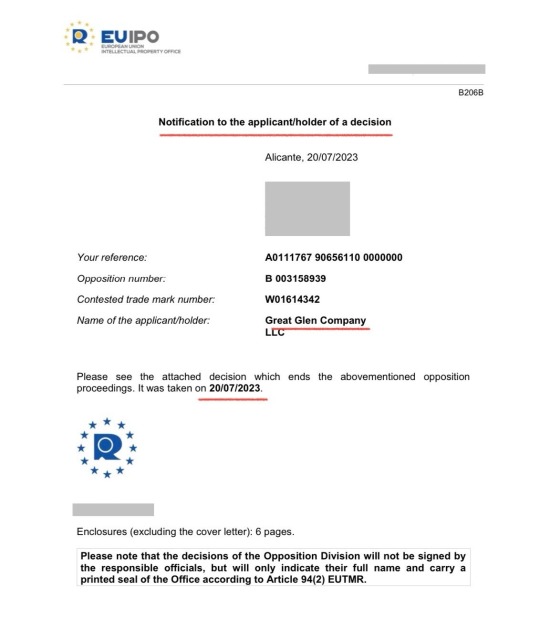
It's a bit curious that after the EUIPO decision, Sam Heughan appeared on a surprise visit to New Orleans, which included podcasts, and events with @sgwinespirits on Tales of the cocktail with an unscheduled tasting of his drinks at the Ritz-Carlton in Nola. Later on, he began his Sassenach sales tour around the United States last summer. If these people had known what had happened with his Sassenach brand in the EU would be different?
In addition, Great Glen Company (GGC) applied to register a new trademark with the World Intellectual Property Organisation (WIPO) and the EU, following the EUIPO decision, following its earlier idea to build on all the Outlander ideas, the new trademark is called "LALLYBROCH SPIRITS" (Lallybroch means "lazy tower" in Gaelic). It will not use Midhope/Lallybroch as a distillery. This new trademark has nothing to do with or relate to the grounds of Midhope Castle, the site of a new whisky distillery with a different brand and ownership. Its new application is already registered in the United States.
It's pending resolution in the EU, Canada and the United Kingdom where Heughan requested its registration.
WIPO

EUIPO
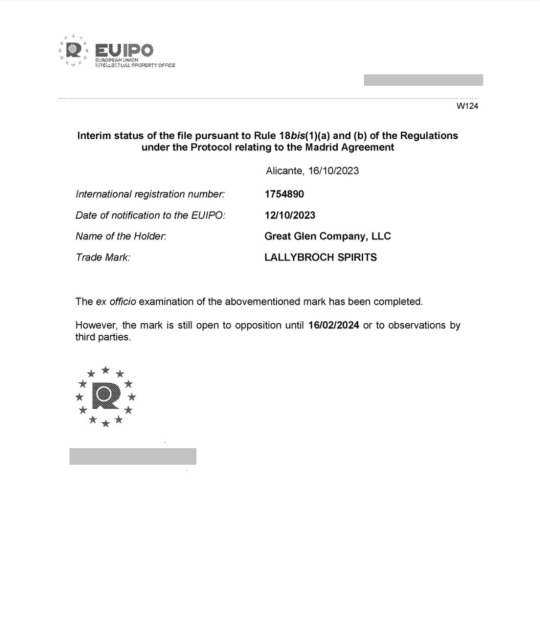
THE SASSENACH UNIQUE SPIRITS
The Great Glen Company, Sam Heughan’s firm, applied to register the brand name Scotch whisky THE SASSENACH UNIQUE SPIRITS as a future trademark to sell the whisky across Europe, but Theo Sasse e.K brand distillery in Schöppingen-Germany, objected claiming the name was too close to its trademarked name, which it uses to sell whiskies and brandies spirits.
On 20th July 2023 the Opposition Division takes the following:
DECISION
1. Opposition is upheld for all the contested goods.
2. International registration is entirely refused protection in respect of the European Union.
REASONS
On 24th November 2021 the opponent Theo Sasse e.K filed an opposition against all the goods (Class 33) of international registration designating the European Union. The opposition is based on, inter alia, German trademark registration ‘Sasse’ (word mark). Also, the opponent invoked Article 8(1)(b) EUTMR and Article 8(4) EUTMR.
LIKELIHOOD OF CONFUSION — ARTICLE 8(1)(b) EUTMR
A likelihood of confusion exists if there is a risk that the public might believe that the goods or services in question, under the assumption that they bear the marks in question, come from the same undertaking or, as the case may be, from economically linked undertakings.
The opposition is based on more than one earlier trade mark. The Opposition Division finds it appropriate to first examine the opposition in relation to the opponent’s German trade mark registration.
a) The goods
The goods on which the opposition is based are, inter alia, the following:
Class 33: Alcoholic beverages, excluding beers. Alcoholic beverages, except beer are identically contained in both lists of goods (including synonyms).
b) Relevant public — degree of attention
The average consumer of the category of products concerned is deemed to be reasonably well informed and reasonably observant and circumspect. It should also be borne in mind that the average consumer’s degree of attention is likely to vary according to the category of goods or services in question. In the present case, the goods found to be identical are directed at the public at large.
c) The signs
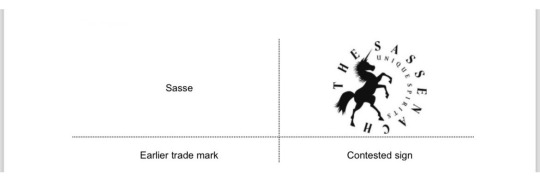
The relevant territory is Germany.
Contested sign The global appreciation of the visual, aural or conceptual similarity of the marks in question must be based on the overall impression given by the marks, bearing in mind, in particular, their distinctive and dominant components. The earlier mark is the word mark ‘Sasse’. The protection of a word mark concerns the word as such and not the specific graphic or stylistic elements accompanying that mark.
The verbal element ‘SASSENACH’ of the contested mark has, contrary to the allegations of the holder, no meaning for the relevant public and is, therefore, distinctive. Likewise, the unicorn device of the contested sign has no particular meaning in relation to the goods and is distinctive.
THE SASSENACH’ in the contested sign are the dominant elements as they are the most eye-catching.
Visually, the signs coincide in ‘SASSE’, which represents the entire earlier mark. The signs differ in the representation of a unicorn and the additional letters ‘-NACH’ (after SASSE) and the non-distinctive elements ‘The’ as well as ‘UNIQUE SPIRITS’ in the contested mark. Thus, the single word element of the earlier mark is fully contained in the most distinctive verbal element of the contested mark. That fact alone is a clear indication of a visual similarity. Therefore, the signs are similar to a below-average degree.
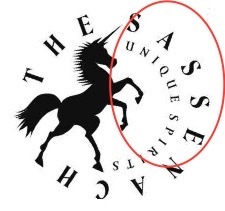
Aurally, the signs coincide in the syllables ‘Sas-se’, which is the sole and distinctive element of the earlier mark and the beginning of the most important verbal element of the contested sign, ‘Sas-se-nach’. The signs differ in the last letters of this word (one syllable), ‘nach’, and in the first verbal element of the contested sign, ‘The’. The fact remains that the earlier mark is entirely included at the beginning of the most important verbal element of the contested sign.
Conceptually, the signs will always be dissimilar as the contested mark will be understood with at least one meaning, namely the unicorn in the contested mark. As the signs have been found similar in at least one aspect of the comparison, the examination of likelihood of confusion will proceed.
d) Distinctiveness of the earlier mark The distinctiveness of the earlier mark is one of the factors to be taken into account in the global assessment of likelihood of confusion. In the present case, the earlier trade mark as a whole has no meaning for any of the goods in question from the perspective of the public in the relevant territory. Therefore, the distinctiveness of the earlier mark must be seen as normal.
e) Global assessment, other arguments and conclusion The goods at issue are identical. They target the general public, who possesses an average degree of attention. The earlier mark has a normal degree of distinctiveness. The signs are visually similar to a below average degree and aurally similar to an average degree since the sole and distinctive element of the earlier mark, ‘Sasse’, is entirely reproduced at the beginning of the contested sign’s only fully distinctive verbal element, ‘Sassenach’. Evaluating the likelihood of confusion implies some interdependence between the relevant factors and, in particular, a similarity between the marks and between the goods or services.
Considering all the above, especially taking into account that the earlier mark is entirely reproduced in the contested sign and used for goods that are identical, the Opposition Division finds that there is a likelihood of confusion on the part of the public. Therefore, the opposition is well founded on the basis of the opponent’s German trade mark registration It follows that the contested trade mark must be rejected for all the contested goods. As the earlier right German trade mark registration leads to the success of the opposition and to the rejection of the contested trade mark The Sassenach for all the goods against which the opposition was directed.
The trademark status was "totally refused", meaning that THE SASSENACH UNIQUE SPIRITS trademark cannot be registered in the EU. If SH's trade mark application is refused, he can file an appeal. He must file his notice of appeal within 2 months from the date of the refusal decision (August-September) and the grounds of appeal must be filed within 4 months from the same date of notification (October-November). But, He did not appeal and last November the EUIPO confirmed by letter the provisional refusal of his trademark and refused its protection in the European Union. The final decision was published on 14 December 2023.

Conclusion
The EUIPO’s decision of the Board of Appeals, regarding its whisky has a “displacement” because Sassenach whisky cannot be registered as a trademark in the EU, the Sassenach trademark was refused. SH must be aware the significance of the total refusal decision regarding its whisky brand. If he was planning to recover from a legal dispute by putting his gin on an impromptu Sassenach tour around US last summer, proving that his recent EU legal battle was a mere bump in the road, he should have thought twice. He lost a legal battle to register his Sassenach whisky brand as a European Community trademark ® in 27 states. It is a big difference. It seems that if Heughan wants to continue selling its whisky, it will have to change the name.
LALLYBROCH SPIRITS registration:
United Kingdom
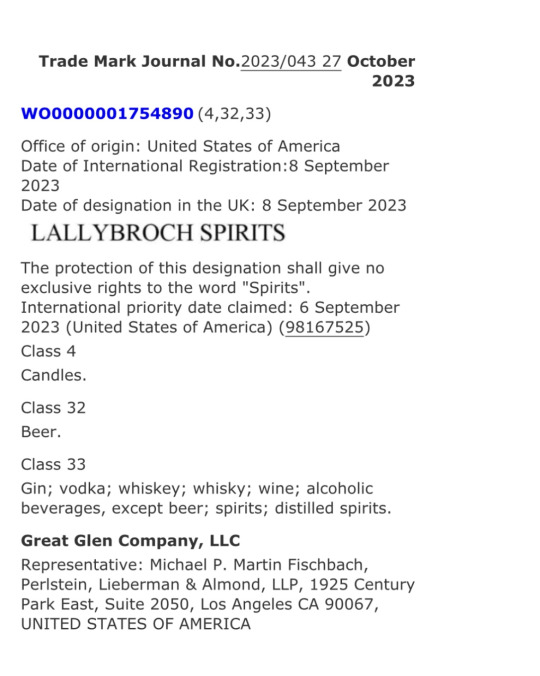
Canada
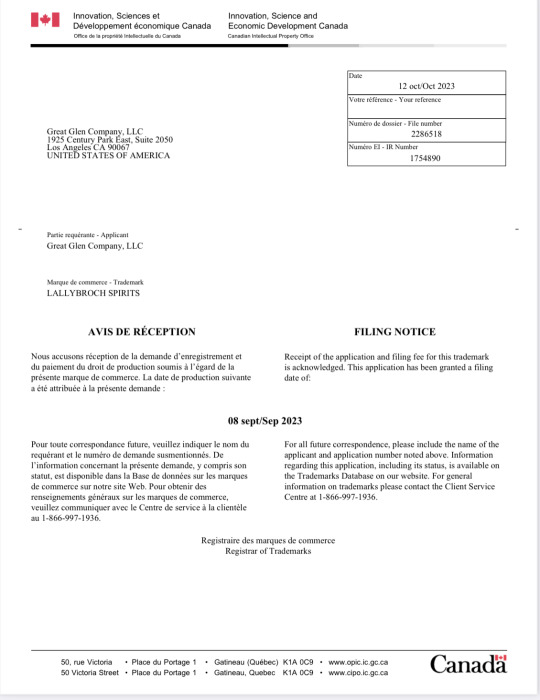
USA
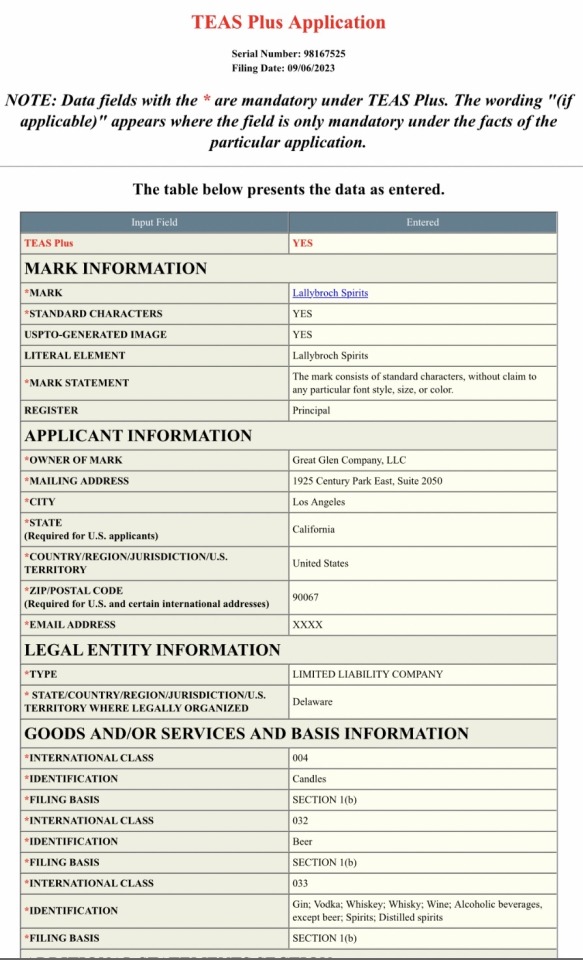
26 notes
·
View notes
Text
Does google ads make you bid for your brands to advertise?
Google works differently according to the country. According to ADIF in European Union using a trademark as keywords in published ads is investigated by google. India has a problem here where google refuses to do that.
The ADIF said.“Credible Indian brands are being put in harm’s way as a result of competitors – both global and domestic – taking advantage of Google’s lax policies. All the while, Google is profiteering from the resulting situation,”
It added, “What is also worth noting is that the company diluted its policy standards for India in 2015 and discontinued investigating trademark registration infringements through keywords. Google stands to profit from the situation it has created due to its diluted policy standards in India.”
Similarly, in a case, Justice V Kameswar Rao of the Delhi High Court said
Google was asked to investigate the matter where advertisers use trademarked words for keywords or combine them with a generic word in the title or texts of an advertisement. It is an infringement to do so.
In googles defense, they had argued that it is advertisers who choose the keywords, acting as an intermediary google cannot be held liable for infringement.
The Executive Director of ADIF Mr.Sijo Kuruvilla George, said: “Companies and individuals spend a considerable amount of time, effort, and resources on building a brand – an intangible asset for any business. It is unethical of Google to encash upon the goodwill and reputation of brands by allowing their competitors to use their registered trademarks as keywords in Google Ads.”
He also added, “The tech giant is profiteering from this practice, all the while hurting credible Indian brands, misleading their trademark registration, and at times even endangering them by exposing them to scam links. There needs to be accountability.”
2 notes
·
View notes
Text
Shocked! McDonald’s iconic “Big Mac” trademark has been cancelled! 💥

On June 5th, the European Court of Justice ruled that McDonald’s failed to provide evidence of its continued use of the “Big Mac” trademark over the past five years, resulting in the cancellation of the trademark. 📜
Such a big brand would lose its trademark due to insufficient evidence! This is enough to illustrate how important the evidence of trademark use is! 🔍
1. What is trademark “withdrawal three” 📜
The term ‘revocation’ refers to the situation where a trademark has not been actually used for three consecutive years after registration, and any third party has the right to apply for the revocation of the trademark. This regulation aims to prevent trademarks from being idle and unused, thereby ensuring the effective utilization of trademark resources in the market.
2. How to retain evidence of use
Evidence type 📑
To protect a trademark, companies must collect and preserve various types of evidence to prove that the trademark has been used in practice. Here are some common and important types of evidence:
Sales records: Detailed sales data, including sales volume, sales time, and sales region. These records can prove the actual use of the trademark in the market.
Advertising materials: All advertising materials related to trademarks, including television commercials, online advertisements, social media promotions, etc. These materials can demonstrate the marketing efforts and frequency of the trademark.
Market research report: A research report on the influence and awareness of a trademark in the market, which can prove the brand’s popularity and market coverage.
0 notes
Text
The Complete Guide to Patent Registration: Safeguard Your Inventions
Understanding Patent Registration: A Comprehensive Guide
Patents are crucial legal tools that protect inventions and innovations, granting exclusive rights to their creators for a specified period. Registering a patent involves a structured process to secure these rights and safeguard intellectual property (IP). This guide explores the essentials of patent registration, from its definition to the steps involved.
What is a Patent?
A patent is a form of intellectual property that provides inventors with exclusive rights to their inventions. It allows the patent holder to prevent others from making, using, selling, or distributing the patented invention without permission. Patents can cover a wide range of inventions, from technological advancements to new processes, designs, or even improvements to existing inventions.
Importance of Patent Registration
Registering a patent offers several key benefits:
Legal Protection: Patents provide legal protection, allowing inventors to enforce their exclusive rights against infringement.
Market Advantage: Patent holders can capitalize on their inventions, gaining a competitive edge in the market by preventing others from copying or exploiting their ideas.
Monetary Value: Patented inventions can be licensed or sold, generating revenue for the inventor or their company.
Types of Patents
There are generally three main types of patents:
Utility Patents: Protect new and useful processes, machines, articles of manufacture, or compositions of matter.
Design Patents: Safeguard new, original, and ornamental designs for articles of manufacture.
Plant Patents: Cover new varieties of plants that are asexually reproduced.
Steps to Register a Patent
The patent registration process typically involves the following steps:
Patent Search: Conduct a thorough search to ensure your invention is novel and not already patented by someone else.
Prepare Patent Application: Draft a detailed patent application that describes your invention, its uniqueness, and how it works. This application must meet specific legal requirements and often includes diagrams, claims, and technical descriptions.
File Patent Application: Submit your patent application to the relevant patent office, such as the United States Patent and Trademark Office (USPTO) or the European Patent Office (EPO). Pay the required filing fees.
Patent Examination: The patent office will examine your application to determine if your invention meets patentability criteria, such as novelty, non-obviousness, and utility.
Publication and Opposition: Once accepted, your patent application may be published. During this period, third parties can oppose the grant of your patent if they believe it does not meet legal requirements.
Grant of Patent: If no opposition is successful and all requirements are met, the patent office will grant you a patent. You will then receive a certificate of patent protection.
Duration and Maintenance of Patents
Patents have a limited duration, typically ranging from 15 to 20 years from the filing date, depending on the type of patent and jurisdiction. To maintain patent protection, patent holders must pay maintenance fees and comply with any post-grant requirements stipulated by the patent office.
Conclusion
Patent registration is a complex yet essential process for inventors looking to protect their innovations and commercialize their ideas effectively. Understanding the nuances of patent law, conducting thorough research, and following the proper procedures are critical for securing and maintaining patent rights.
0 notes
Text
The Importance of Registering a Trademark in Europe
In today’s highly competitive global market, securing your brand is more crucial than ever. For businesses looking to establish or expand their presence in Europe, it is essential to register trademark Europe. Doing so not only protects your brand but also enhances its value across a vast and diverse market.

Why Register a Trademark in Europe?
When you register a trademark in Europe, you gain exclusive rights to your brand in all 27 European Union member states. This means you are legally protected from unauthorized use, imitation, or infringement throughout a significant portion of the global market. Whether you’re selling products or services, having your trademark registered in Europe ensures that your brand is safeguarded against competitors.
The Benefits of European Trademark Registration
Comprehensive Protection:
A European trademark registration offers coverage across all EU countries, making it an efficient way to protect your brand across multiple jurisdictions with a single application.
Cost-Effective:
Instead of registering trademarks individually in each country, you can register a trademark in Europe through a single application process, saving both time and money.
Brand Recognition:
A registered trademark in Europe helps establish and reinforce your brand identity, making it easier for consumers to recognize and trust your products or services across the continent.
How to Register a Trademark in Europe
To register a trademark in Europe, you must file an application with the European Union Intellectual Property Office (EUIPO). The application should include a clear representation of your trademark and specify the goods or services it covers. Once approved, your trademark will be protected across all EU member states.
Conclusion
Registering a trademark in Europe is a strategic move for any business aiming to protect its brand and thrive in one of the world’s most lucrative markets. By securing your trademark, you not only safeguard your intellectual property but also strengthen your brand’s reputation and market position across Europe.
#Register Trademark Europe#eu trademark#register trademark eu#trademark search eu#trademark registration europe
0 notes
Text
Dairy Alternatives Market Analysis By Major Manufacturers and Competitive Landscape (2022 - 2028)
In recent years, the global food industry has witnessed a significant shift in consumer preferences, with a growing trend towards dairy alternatives. This transformation reflects changing attitudes towards health, sustainability, and ethical concerns. As more people choose to reduce or eliminate dairy from their diets, the demand for dairy alternatives has surged.
At a robust 10.1% CAGR, the global dairy alternatives market value is projected to reach USD 43.6 billion by 2028, up from an estimated USD 27.0 billion in 2023. In 2022, the market was valued at USD 24.6 billion. A major driver behind this growth is the increasing focus on health and wellness. Health-conscious consumers are seeking products that align with their dietary needs, and dairy alternatives such as almond, soy, and oat milk have become popular choices. These alternatives are often perceived as healthier due to their lower saturated fat content and absence of cholesterol. Moreover, many are fortified with essential vitamins and minerals, appealing to those striving for a balanced diet.
How are Dairy Alternatives Manufacturers Responding to the Rapid Growth Of the Vegan Population?
The growth of the dairy alternatives market is primarily driven by the global shift towards vegetarian and flexitarian diets. These dietary preferences have gained significant popularity, influenced by various factors such as concerns about animal welfare, environmental issues, and personal health. Veganism has emerged as a lifestyle choice that abstains from consuming animal-derived products, including dairy. The increasing worldwide condemnation of animal cruelty has further boosted the demand for dairy substitutes. Many consumers view a vegan diet as a healthy choice and opt for dairy alternatives like soy milk, almond milk, rice milk, and other plant-based options instead of traditional dairy milk.
Make an Inquiry to Address your Specific Business Needs
Significant growth in the vegan population has been observed in major economies like the United States and the United Kingdom. Consumers in developed nations embrace plant-based milk as it offers energy, health benefits, aids in weight management, and enhances the taste of food. According to The Vegan Society, avoiding meat and dairy consumption plays a crucial role in reducing the environmental impact, particularly concerning carbon emissions. Currently, the livestock industry contributes an estimated 18% to total greenhouse gas emissions across the five major sectors for greenhouse gas reporting. Within the agricultural sector, farmed animals are responsible for nearly 80% of all emissions. This environmental concern has prompted environmentally conscious consumers to shift towards dairy alternatives.
In 2021, The Vegan Society recorded 16,439 products bearing The Vegan Trademark, with over 82% of these registrations occurring in the past five years. The Vegan Trademark is now recognized in 87 countries globally, and more than half of the registered products come from companies located outside the UK. Given the rapid growth of the vegan population, numerous dairy manufacturers are transitioning towards producing plant-based milk products, which is expected to have a positive impact on the plant-based beverages market.
What strategies are companies adopting to capitalize on the fastest-growing CAGR in Europe?
The European Union is one of the biggest dairy exporters in the world. Thus, conventional dairy has a huge share in the European market as compared to dairy alternatives. However, despite the dominance of the dairy sector in the region, a surge in the growth of the dairy and plant-based alternatives sector has been observed in recent years. Many retailers and supermarket giants are adding soy drinks and rice drinks to their product shelves as they are witnessing an increase in sales of dairy alternatives. The rise in demand for dairy-free food & beverage products that are environmentally sustainable and healthy is driving the Europe dairy alternatives market.
Consumers in the European market prioritize health, as well as demonstrate awareness of animal welfare and environmental sustainability. Consequently, they frequently scrutinize product ingredients prior to making purchases. This heightened awareness has led to an upsurge in demand for low-fat and lactose-free food options. As a result, major industry leaders are shifting their focus towards acquiring other businesses and broadening their product offerings to incorporate plant-based dairy alternatives. In 2017, French dairy player Danone acquired WhiteWave Foods, a specialist in dairy alternatives. According to Fi Global Insights 2021, Germany has recently replaced the UK as the top consumer of dairy alternatives in the region.
What’s New in the Dairy Alternatives Industry?
In June 2023, Oatly Group AB (Sweden) launched a vegan cream cheese, now available nationwide in the US. This oat-based cream cheese comes in two flavors: Plain and Chive & Onion.
In April 2021, SunOpta acquired the Dream and WestSoy plant-based beverage brands from The Hain Celestial Group, Inc. This acquisition expanded SunOpta’s product portfolio, further accelerating growth in the dairy alternatives business.
Urbanization, Dietary Diversification, and Investment: Shaping the Asia-Pacific Dairy Alternatives Industry
The Asia-Pacific region is witnessing a surge in demand for fortified nutritional food and beverages, driven by busy lifestyles and rising disposable incomes. This trend is accelerating the adoption of dairy alternatives, particularly soy milk, as consumer preferences evolve. Economic growth in the region is expected to further boost the consumption of affordable and abundant soy milk. To cater to the growing interest in healthy and pasteurized dairy substitutes, food manufacturers are diversifying their soy milk offerings with unique flavors. Additionally, rising income levels, a growing middle class, heightened health awareness, and the demand for nutritional products are creating significant growth opportunities in the Asia-Pacific dairy alternatives market.
This analysis focuses on key countries within the region, including Japan, Australia, China, and India. Major players such as Sanitarium Health & Wellbeing Company, Freedom Foods Group Ltd., Vitasoy International Holdings Limited, and PureBates are central to the expanding dairy alternatives market. The sector is rapidly evolving due to urbanization, dietary diversification, and increased foreign investment in the food industry.
Insights into the Dairy Alternatives Market Report: What You Need to Know
What is the current size of the dairy alternatives sector?
What are the prevailing dairy alternatives market trends?
Are there specific insights for Oceania (New Zealand and Australia) regarding market size, key players, and growth rates?
Leading Dairy Alternatives Manufacturers
Danone North America Public Benefit Corporation (US)
The Hain Celestial Group, Inc. (US)
Blue Diamond Growers (US)
Freedom Foods Group Limited (Australia)
Valsoia S.p.A (Italy)
SunOpta (Canada)
Oatly Group AB (Sweden)
Sanitarium (New Zealand)
Request Custom Data to Address your Specific Business Needs
0 notes
Text
Everything You Should know about Collective Trademark
A collective trademark is a specialized type of trademark that functions to identify goods or services provided by members of a particular group, rather than just a single business. Here’s a comprehensive overview of collective trademarks:
Definition
A collective trademark is a trademark owned by an organization or association that signifies that the goods or services provided by its members meet certain standards or belong to a particular group. The key aspect is that it distinguishes the products or services of the members of the organization from those of non-members.
Key Characteristics
Ownership and Use:
The collective trademark is owned by a collective organization or association.
It can be used by any member of the collective organization, provided they adhere to the organization's standards and regulations.
Purpose:
To indicate membership in a collective group.
To maintain quality standards for goods or services provided by members.
To promote the collective interests of the members.
Not For Individual Profit:
Unlike traditional trademarks, collective trademarks are not meant for profit by the collective organization itself, but rather to benefit the members of the organization.
Types of Collective Marks
Collective Trademarks:
These are used to indicate that the goods or services come from members of a particular organization.
Collective Service Marks:
Similar to collective trademarks, but specifically used to identify services provided by members of the organization.
Collective Certification Marks:
These marks are used to certify that goods or services meet certain standards set by the certifying organization. The organization itself does not provide the goods or services but certifies that they meet specific criteria.
Registration and Use :-
Registration:
To obtain protection for a collective trademark, the organization must file an application with the relevant trademark office (e.g., the U.S. Patent and Trademark Office, European Union Intellectual Property Office).
The application must include details about the organization, the rules governing the use of the mark, and the nature of the goods or services.
Rules and Regulations:
The organization must have clear rules for membership and use of the mark.
There must be provisions for monitoring and enforcing compliance with the rules.
Enforcement:
The organization is responsible for ensuring that the mark is used correctly by its members and for taking action against unauthorized use.
Examples
Trade Associations: Organizations like the American Bar Association (ABA) use collective trademarks to signify that their members meet certain professional standards.
Certification Marks: Marks like the “UL” (Underwriters Laboratories) mark on electrical products certify that the product has met safety standards, even though UL itself does not manufacture the products.
Advantages
Quality Assurance: Helps consumers identify products or services that meet a certain standard or come from a reputable source.
Group Identity: Provides a unified brand identity for members of the organization.
Marketing Power: Enhances the collective market presence and recognition of the group’s products or services.
Considerations
Management: Managing a collective trademark requires diligent oversight and administration to ensure proper use and compliance.
Dispute Resolution: Organizations must have mechanisms in place for resolving disputes related to the use of the mark.
In summary, collective trademarks play a crucial role in promoting and maintaining standards among members of a collective organization, ensuring that consumers can identify and trust the quality of the goods or services associated with the mark.
0 notes
Text
Trademark Registration Process
The legal process of securing the owner's exclusive right to use a specific symbol, term, phrase, design, or combination to identify and set their goods and services apart is known as trademark registration. This is a thorough description of the steps involved in registering a trademark:

Initial Trademark Search Steps:
Make sure the trademark is distinct and not currently in use by conducting a comprehensive search. By doing this, disputes and other legal problems are avoided.
Submitting the Application Preparing the Application:
Choose a regular character mark (text only) and a special form mark (logo, design) for your trademark.
Determine the products or services that are linked to the trademark and are categorized using the Nice Classification system.
Send in the Application
Apply to the appropriate trademark office, such as the European Union Intellectual Property Office (EUIPO) in the EU, the United States Patent and Trademark Office (USPTO) in the US, or other national/regional offices.
Give the necessary details, such as the owner's identity, a list of the goods and services, a representation of the trademark, and the reason for filing (use in commerce or intent to use).
Exam Procedure
Official Review: The application is examined by the trademark office to make sure it conforms with official specifications.
Comprehensive Analysis: The office verifies that the application is unique and looks for trademark disputes.
Publishing and Counterpublications:
The public is informed when an application passes an examination and is published in a journal or official gazette.
Time of Opposition: a predetermined window of time, usually between 30 and 3 months, during which outside parties may submit an objection if they disagree that the trademark should be registered.
Enrollment:
Absence of Resistance or a Viable Resolution:
The trademark moves on to registration if no opposition is lodged or if opposition is dismissed in the applicant's favor.
The awarding of a certificate:
A registration certificate, which confers exclusive rights to the trademark, is issued by the trademark office.
Post-Registration Upkeep and Extension:
Generally, trademarks must be renewed regularly (every ten years in many jurisdictions).
Certain countries need periodic proof of use to keep the registration active.
Observation and Implementation:
Keep a regular eye out for any possible violations in the market.
Protect your trademark rights by going to court if required.
Madrid System for International Trademark Registration:
Regulated by the World Intellectual Property Organization (WIPO), which enables the submission of a single application to request protection across several of its member nations.
just a simple application and registration in the nation of origin.
Submit a worldwide application via the trademark office of your native nation.
The application is sent by WIPO to the chosen member nations for review and registration.
Businesses and individuals can obtain trademark protection by following these steps, guaranteeing that their brand identity is legally protected and solely theirs.
To know more information visit at www.corpbiz.io or can Contact on 9121230280
0 notes
Photo
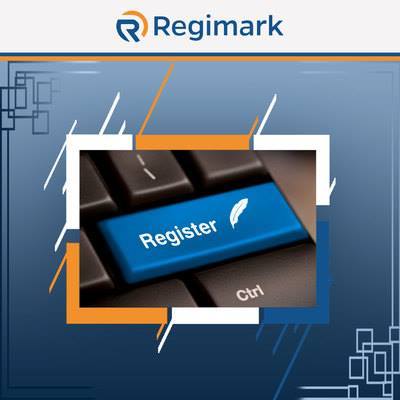
Trademark Registration in the European Union
Registration is confirmed by the issuance of the trademark registration certificate. A trademark owner has the right to use the trademark, sell or license it and prevent others from using his trademark in relation to goods and services for which it is registered.
Know More: https://regimark.eu/eutm-registration/
0 notes
Text
International Trademark Registration: Global Trademark

International trademark registration allows businesses to protect their trademarks across multiple countries through streamlined systems like the Madrid System, administered by the World Intellectual Property Organization (WIPO), and the European Union Trademark (EUTM) system, administered by the European Union Intellectual Property Office (EUIPO). By filing a single application, businesses can seek protection in numerous member countries, simplifying the process of securing and managing trademark rights globally. This approach not only reduces the administrative burden but also ensures a unified protection strategy, essential for maintaining brand integrity and preventing unauthorized use in international markets.
For More Information about International Trademark Registration
0 notes
Text

Maybe it means that no matter how hard you try you can’t change reality to suit your needs. 🤔
Merely making external improvements in The Sassenach brand cannot conceal or change the decision-making about his trademark in the EU. Once the shine of its brand, The Sassenach, faded last year in the EU, SH cannot add more glitter to the brand as it wished in the EU.
He has made sales in his online shop with regular customers (fans) and has also liaised with friends who own restaurants in Scotland 🏴 to sell his alcohol in an attempt to enter the UK market.
However, in the European Union 🇪🇺 Only by registering your trademark do you obtain legal rights over it, make exclusive use of it in the whole territory of the European Union and prohibit its use by unauthorised third parties. But the registration of the Sassenach was refused in the EU*
If you constantly post about your booze...99.9%, you still miss it. Stop fooling yourself and others.

Why is important a European Union’s trademark?
European Union’s trademark ® system (formerly known as the “community trademark”) has been operational since 1996, its registration provides protection for a trademark in the 27 member states of the European Union 🇪🇺
The EU trademark system is an alternative to filing national trademark applications in each Member State of the European Union, making it a much faster and cheaper system of protection. Trademarks like patents, are territorial rights, so their effects only can extend to the territory or territories where protection is requested.
As the European Union is currently made up of 27 member states, When new countries join the European Union, EU trademark protection will also extend to those countries. The European Union trademark system does not allow certain countries to be left out of trade mark protection. For example, an applicant who is going to use the trademark in ten countries will not be able to exclude the remaining seventeen.
Among the advantages, we can highlight its agility, time and cost savings in the process (a single application for registration for all states). In today's digital environment, where borders do not exist, it is more important than ever to establish a good trademark protection strategy to avoid possible copying or misuse of trademarks.
Registering a trade mark in the EU can avoid possible future conflicts. It implies the possibility that, as long as the trademark meets the requirements set out in the Community Trade Mark Regulation and there is no earlier identical or similar trademark registration application, and it can be granted for all countries at the same time. Therefore, it must be borne in mind that the viability of such a trademark registration will be reviewed by each of the 27 countries.
By registering an EU trademark, you obtain an exclusive licence for a trademark throughout the European Union and can obtain trademark protection in up to 170 other countries, through the concept of an "international trademark".
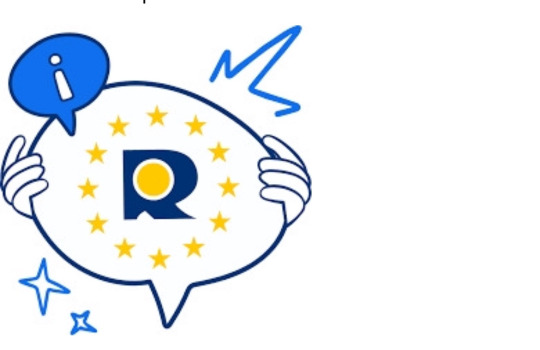
*Class 33: Alcoholic beverages, excluding beers.
5 notes
·
View notes
Text
Expanding Your Brand Globally: A Guide to International Trademark Registration
Expanding your brand into international markets is an exciting and lucrative venture. However, with the global reach comes the crucial responsibility of protecting your brand identity. Trademarks, which include logos, slogans, and brand names, are fundamental assets that distinguish your products or services from competitors. Securing international trademark registration is essential to safeguard your brand across borders.
This comprehensive guide will walk you through the process, delivering valuable insights and practical steps for successful international trademark registration.

Understanding Trademarks and Their Importance
What is a Trademark?
A trademark is a symbol, word, or group of words legally registered or established by use as representing a company or product. It can include names, logos, slogans, sounds, and even colors that distinguish your goods or services from others in the market.
Why are Trademarks Important?
Brand Identity: Trademarks help consumers identify and differentiate your products from others, fostering brand loyalty.
Legal Protection: They provide legal protection against unauthorized use of your brand elements.
Business Asset: Trademarks are valuable intangible assets that can be appreciated over time.
Market Expansion: They enable smoother entry into new markets by protecting your brand in foreign jurisdictions.
Preparing for International Trademark Registration
Conducting a Trademark Search
Before filing for trademark registration, it’s crucial to conduct a comprehensive trademark search in your target markets. This step helps to ensure that your trademark is unique and not already in use, preventing potential legal disputes and rejection of your application.
Steps to Conduct a Trademark Search:
Identify Classes: Trademarks are categorized into different classes based on the type of goods or services. Identify the appropriate classes for your trademark.
Use Online Databases: Utilize online trademark databases such as the World Intellectual Property Organization (WIPO) Global Brand Database, the United States Patent and Trademark Office (USPTO) database, and other national databases to search for existing trademarks.
Professional Assistance: Consider hiring a trademark attorney or a professional search service to ensure a thorough search.
Evaluating Trademark Eligibility
Not all trademarks are eligible for registration. Your trademark must be distinctive, not descriptive or generic, and must not conflict with existing trademarks. Additionally, it must not contain misleading or offensive content.
Choosing the Right Markets
Identify the countries where you plan to expand and where trademark protection will be beneficial. Consider factors such as market potential, brand relevance, and local trademark laws. Prioritize countries with significant market opportunities and those where your brand is most likely to face competition or imitation.
Pathways to International Trademark Registration
There are several pathways to register your trademark internationally, each with its advantages and disadvantages. The choice depends on your business needs, budget, and target markets.
National Applications
You can file individual trademark applications directly with each country’s trademark office. This method allows for tailored applications according to specific national laws but can be time-consuming and expensive if you target multiple countries.
Pros:
Customized protection tailored to each country’s laws.
Direct communication with national trademark offices.
Cons:
High costs and administrative burden.
Varied registration procedures and timelines.
Regional Applications
For regions with unified trademark systems, such as the European Union (EU) and the African Intellectual Property Organization (OAPI), you can file a single application that covers all member countries.
Pros:
Simplified process for multiple countries within the region.
Cost-effective for regional protection.
Cons:
Limited to specific regions.
If opposed in one country, it can affect the entire application.
The Madrid System
The Madrid System, administered by WIPO, offers a centralized solution for registering trademarks in multiple countries through a single application. It currently covers over 120 countries, making it an efficient choice for broad international protection.
Pros:
Single application and fee for multiple countries.
Simplified management and renewal process.
Flexibility to designate additional countries later.
Cons:
Dependent on the basic application/registration in the home country for the first five years.
Not all countries are members.
Steps to Register Your Trademark Internationally Using the Madrid System
Basic Application or Registration
To use the Madrid System, you must first have a trademark application or registration in your home country (known as the basic application or basic registration). This serves as the foundation for your international application.
Filing the International Application
Submit your international application through your home country’s trademark office (Office of Origin). The application must include:
Your details and signature.
Representation of the trademark.
List of goods and services categorized according to the Nice Classification.
Designation of member countries where you seek protection.
Examination by WIPO
WIPO examines the application for compliance with formal requirements and then publishes it in the WIPO Gazette of International Marks. It then forwards the application to the trademark offices of the designated countries.
Examination by Designated Countries
Each designated country’s trademark office examines the application according to its national laws. They may approve, partially refuse, or completely refuse the application. You must respond to any refusals or objections within the given timeframe.
Registration and Protection
Once approved by a designated country, your trademark is protected in that country as if it were registered directly with its trademark office. The protection period is generally 10 years, with the possibility of renewal.
Managing and Enforcing International Trademarks
Renewing Your Trademark
Trademark registrations must be renewed periodically, typically every 10 years. The Madrid System allows you to manage renewals centrally, simplifying the process for multiple countries.
Monitoring and Enforcement
Regularly monitor the use of your trademark in international markets to detect unauthorized use or infringement. Take swift legal action against infringers to protect your brand’s integrity. Consider using trademark watch services and engaging local legal counsel for enforcement actions.
Licensing and Franchising
Consider licensing or franchising your trademark to third parties in foreign markets. This can provide additional revenue streams while expanding your brand’s presence. Ensure that license agreements are carefully drafted to protect your trademark rights and maintain quality control.
Tips for Successful International Trademark Registration
Seek Professional Assistance
Trademark registration, especially internationally, can be complex. Engage experienced trademark attorneys or agents who specialize in international trademark law to navigate the process effectively.
Plan Ahead
Trademark registration can take time, often several months to years. Plan your registration strategy well in advance of entering new markets to ensure your brand is protected when you launch.
Be Consistent
Maintain consistency in your trademark usage across all markets. This includes using the same logo, slogan, and brand name. Consistent usage strengthens your brand identity and legal protection.
Understand Cultural Differences
Be aware of cultural differences and language translations that may affect your trademark. Ensure that your trademark does not have unintended negative connotations in different languages or cultures.
Keep Records
Maintain comprehensive records of your trademark registrations, renewals, and enforcement actions. This documentation is vital for managing your trademark portfolio and defending your rights.
Final Words
Expanding your brand globally presents tremendous opportunities for growth and increased market presence. However, it also requires meticulous planning and proactive measures to protect your brand identity. International trademark registration is a critical step in this process, safeguarding your brand from infringement and ensuring legal protection in foreign markets.
By conducting thorough trademark searches, understanding the various pathways to registration, and effectively managing your trademarks, you can navigate the complexities of international trademark registration with confidence. Seek professional assistance, plan, and stay vigilant in monitoring and enforcing your trademark rights. With the right strategy, your brand can thrive on the global stage, enjoying the benefits of expanded reach and recognition.
Embark on your journey of global expansion with the assurance that your brand is well-protected, paving the way for sustained success and growth in the international arena.
0 notes
Text
Trademark Registration: Safeguarding Your Brand
Trademark registration is a fundamental legal process that provides essential protection for your brand identity, ensuring that it remains unique and safe from unauthorized use. In this comprehensive guide, we will delve deep into the intricacies of trademark registration, exploring its significance, the step-by-step registration process, and the crucial measures required to secure your brand's identity. By the end of this extensive article, you will have a profound understanding of trademark registration, its numerous benefits, and how it can fortify your brand's position in the market.
Section 1: The Power and Purpose of Trademarks
In this section, we will establish a solid foundation of understanding regarding trademarks, their significance, and the pivotal role they play in securing and protecting your brand.
1.1 What Is a Trademark?
Defining trademarks and their scope
The various types of trademarks: word marks, logos, slogans, and more
The essential role of trademarks in brand protection
1.2 The Benefits of Trademarks
The exclusive rights conferred by trademarks
Amplified brand recognition and increased consumer trust
Legal remedies in cases of trademark infringement
Section 2: The Comprehensive Trademark Registration Process
In this section, we will guide you through the intricate step-by-step process of registering a trademark, ensuring your brand's exclusivity and security.
2.1 Preparing for Trademark Registration
The importance of preliminary searches and clearance checks
Identifying the appropriate class of goods or services for your trademark
Crafting a strong trademark: Understanding distinctiveness and registrability
2.2 Filing the Trademark Application
Choosing between online application or paper filing
Collecting the required documents and comprehending the associated fees
Understanding the critical role of the USPTO (United States Patent and Trademark Office)
2.3 Examination and Publication
In-depth insight into the examination process and potential objections
The process of publication in the Official Gazette
Navigating opposition proceedings in case of challenges to your trademark
2.4 Registration and Maintenance
The significance of receiving the Certificate of Registration
Responsibilities for maintaining trademark protection
Renewal requirements and associated timelines to keep your trademark active
Section 3: Extending Your Brand's Protection Globally
For those with international ambitions, it's vital to comprehend how to protect your brand on a global scale through trademark registration.
3.1 The Madrid Protocol
An overview of the Madrid Protocol and its global significance
Benefits and limitations of this international trademark system
A step-by-step guide to filing an international application under the Madrid Protocol
3.2 Regional Trademark Systems
Exploring regional trademark systems such as the European Union Trademark (EUTM)
Understanding the role of the African Regional Intellectual Property Organization (ARIPO)
The relevance of the Andean Community in the context of brand protection
Section 4: Enforcing Your Trademark Rights
Having successfully secured your trademark, it's crucial to understand how to protect it and take action against infringements.
4.1 Detecting Infringement
Establishing mechanisms for monitoring and enforcing your trademark
Sending cease and desist letters as an initial course of action
Resorting to litigation as a last line of defense in severe infringement cases
4.2 International Enforcement
Strategies for protecting your trademark rights on an international scale
The role of international treaties in facilitating cross-border enforcement
Collaborating with international law firms to ensure effective global protection
Section 5: Understanding the Costs of Trademark Registration
Trademark registration involves various costs. In this section, we will break down the expenses associated with safeguarding your brand's identity and reputation.
5.1 Application Fees
An in-depth examination of government application fees and cost considerations
Understanding additional fees related to registering in multiple classes
A comprehensive look at the expenses associated with international trademark applications
5.2 Legal Costs
An evaluation of the decision between handling the registration process independently and hiring a trademark attorney
The advantages and disadvantages of DIY registration versus seeking professional assistance
The value of trademark watch services in preserving your brand's integrity and reputation
Section 6: Trademark Registration in the Digital Age
As the digital landscape continues to evolve, new challenges and opportunities arise in the realm of trademark registration.
6.1 Protecting Your Brand Online
Strategies for protecting your brand's online presence, including domain names
Managing the relationship between domain names and trademark protection
Leveraging social media to maintain and strengthen your brand's identity
6.2 AI and Trademark Searches
Harnessing the power of artificial intelligence for comprehensive trademark searches
Reducing the risk of trademark conflicts through advanced search technology
Conclusion
In today's fiercely competitive business landscape, safeguarding your brand is of paramount importance. Trademark registration offers a robust framework for ensuring the exclusivity and integrity of your brand's identity, bolstering its reputation and value. Whether you're a small business owner or part of a multinational corporation, trademark registration is a valuable tool for securing your brand's position in the market and protecting it from potential threats. Understanding the registration process, associated costs, and the evolving digital landscape is crucial for making informed decisions about your brand's future. By taking the necessary steps to register your trademark, you are investing in the long-term success and recognition of your brand, solidifying your position in the marketplace. Don't leave your brand's identity to chance; make trademark registration a top priority today.
0 notes